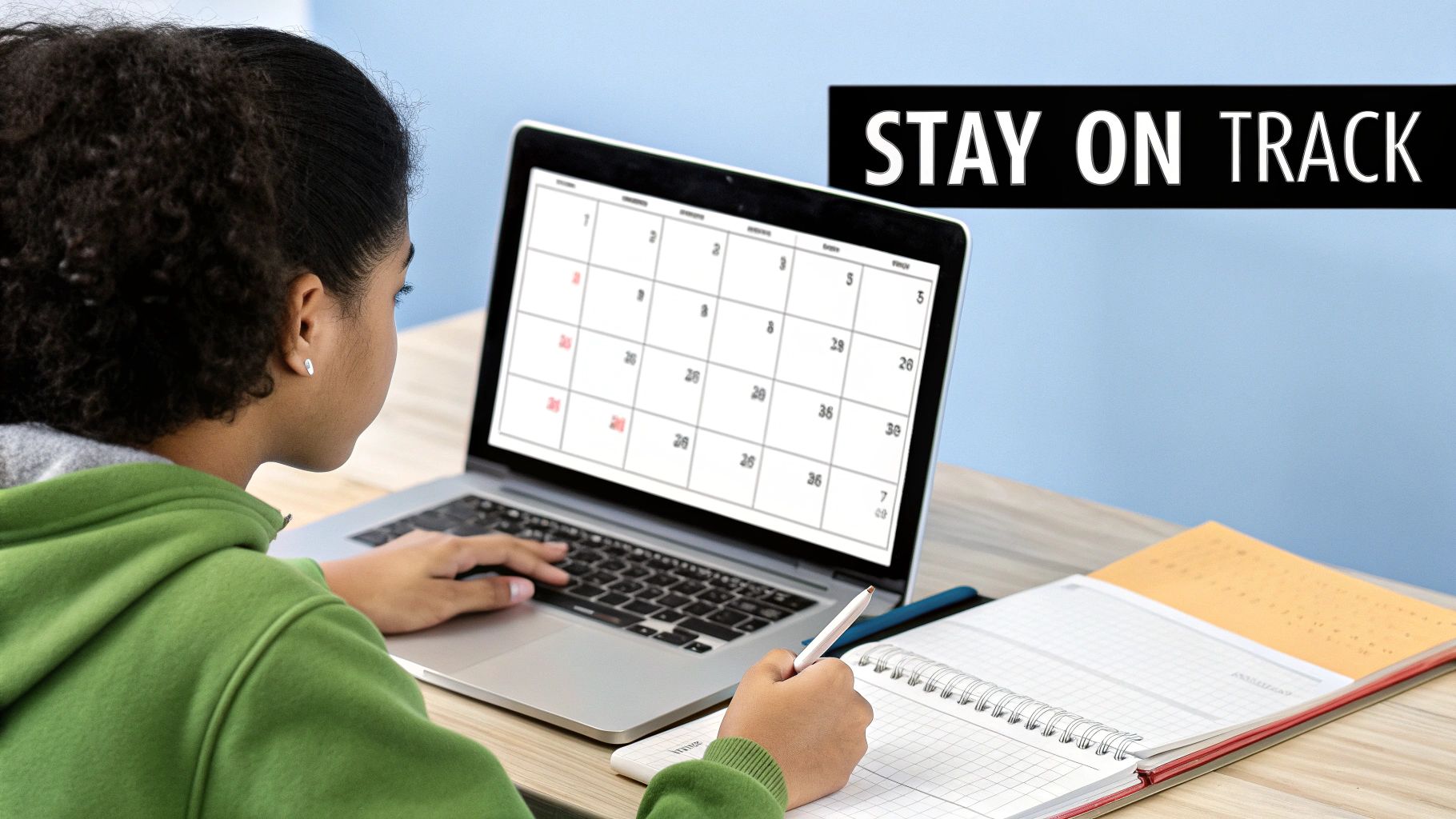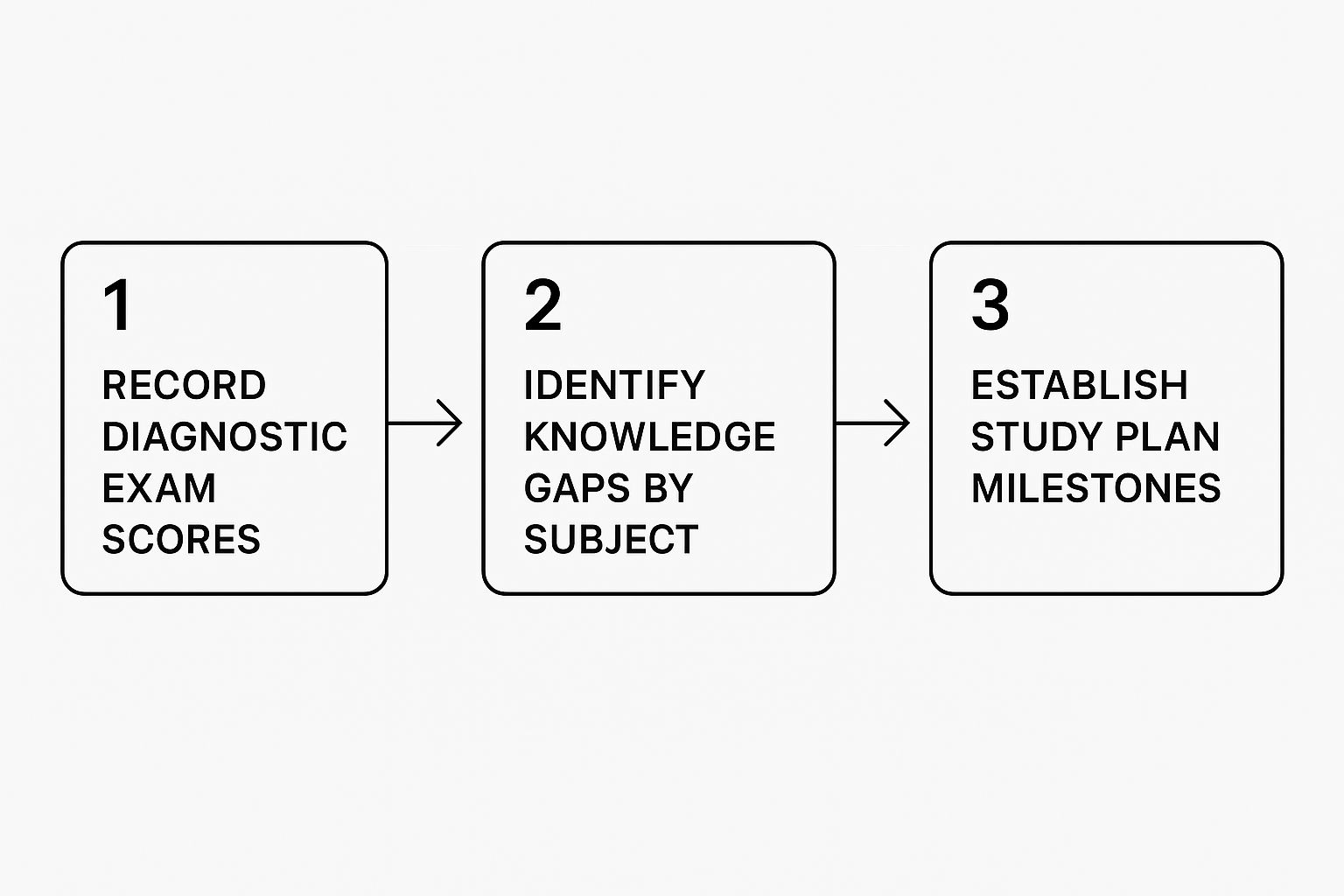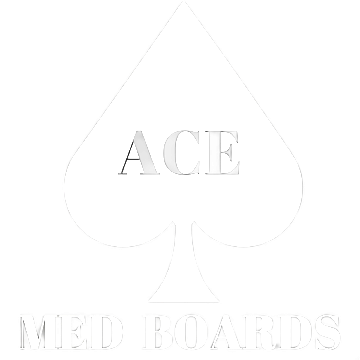A truly effective USMLE Step 1 study calendar isn't something you can just download. It's a personalized roadmap you build for yourself. This process starts with an honest self-assessment, picking a realistic timeline—like a 6 or 12-week block—and setting clear goals based on where you stand right now. This foundational work is what turns scattered studying into a focused, strategic campaign.
Crafting Your Foundation for USMLE Success

Before you even think about plugging daily topics into a spreadsheet, you have to lay the groundwork. So many students make the mistake of jumping straight into a detailed schedule without first understanding their own learning needs. Frankly, it’s a recipe for burnout and wasted effort. A successful prep journey always begins with a bit of introspection and solid planning.
First up is a frank self-assessment. I'm not talking about your med school grades. You need to pinpoint your actual strengths and weaknesses across the basic sciences. Are you a pathology whiz but biochemistry makes your head spin? Do pharmacology mechanisms feel like second nature, while neuroanatomy seems like a foreign language? This kind of honest evaluation is what helps you allocate your most precious resource—your time—where it will make the biggest difference.
Define Your Study Timeline
Next, you need to decide on the right study period for you. There's no single magic number here, but most students find a dedicated period between 6 to 12 weeks hits the sweet spot.
A shorter, more intense schedule can work wonders if you already have a strong foundation and can realistically commit to 10-12 hours of focused study every single day. On the other hand, a longer timeline gives you room to breathe, which is a huge advantage if you're trying to balance studying with other commitments.
A common mistake is underestimating the time needed for comprehensive review. Factoring in days for rest and unexpected delays is not a sign of weakness; it’s a hallmark of a mature and sustainable study plan.
Establish a Realistic Baseline
Once you have a timeline in mind, it's time to figure out your starting point. Taking a diagnostic test, like an NBME practice exam, gives you an objective snapshot of where you are right now.
This initial score isn't a judgment—it's just data. It helps you set achievable goals and track your progress in a meaningful way. For instance, seeing a low score in immunology is an immediate, clear signal that this subject needs more attention in your USMLE Step 1 study calendar.
If you're looking to optimize how you learn, exploring proven study tips can give you a real edge in focus and retention.
Ultimately, this foundational phase is all about building a plan that actually serves you. It forces you to:
- Identify High-Yield Gaps: Focus your energy on topics that are frequently tested and where your knowledge is weakest.
- Set Clear Milestones: Instead of just aiming for a final score, set smaller, more manageable goals, like mastering the cardiovascular system within the first two weeks.
- Be Realistic About Your Capacity: Acknowledge your limits. You want to avoid creating a schedule that's impressive on paper but impossible to maintain in real life.
For a deeper dive into this process, our guide on https://acemedboards.com/how-to-study-for-usmle-step-1/ offers even more strategies for building an effective plan from the ground up.
Building Your Daily and Weekly Study Structure
Alright, you’ve got your timeline sketched out. Now it's time to get into the nitty-gritty: designing the day-to-day rhythm of your study plan. A solid, repeatable structure is what turns that mountain of information into small, manageable hills you can conquer one by one. The goal here is to create a predictable flow that builds momentum without burning you out.
Successful study plans almost always move through distinct phases. Your first block of time should be all about systematic content review. This is where you methodically plow through the core subjects—think pathology, pharmacology, physiology, and biochemistry. You're laying the foundation, one brick at a time.
Once that foundation is solid, you'll shift into a more integrated phase. This is where the real learning kicks in. Instead of studying subjects in a vacuum, you'll start blending them with active learning, primarily through question banks (Qbanks). For example, a "cardiology" day might involve watching a video on antiarrhythmics, flipping through the corresponding chapter in First Aid, and then immediately tackling a 40-question UWorld block on that exact topic.
Designing Your Weekly Template
A consistent weekly template is your best friend. It gives you structure and cuts down on decision fatigue—no more waking up wondering, "What should I study today?" While you should always be ready to adapt, having a solid starting point is crucial.
Here’s a practical way to break down your days:
- Morning (3-4 hours): Hit the new content. Your mind is sharpest in the morning, making it the perfect time to tackle complex topics or your weakest subjects.
- Afternoon (3-4 hours): Switch to active recall with your Qbank. Do timed, random blocks of questions to get used to exam conditions. The real work isn't just doing the questions; it's meticulously reviewing every single one.
- Evening (1-2 hours): Wind down with some lighter review. This is a great time for running through your Anki deck for spaced repetition or quickly re-reading notes on the day’s trickiest concepts.
This creates a powerful daily cycle: learn it, apply it, and reinforce it. It's worlds more effective than just passively reading a textbook for eight hours straight.
The single most critical part of your daily schedule is the time you dedicate to reviewing Qbank questions. A good rule of thumb is to budget at least as much time for reviewing a block as you spent completing it. Seriously. Understanding why you got a question right is just as important as figuring out why you got one wrong.
The Final Push Phase
The last one to two weeks of your usmle step 1 study calendar are all about building stamina and cementing knowledge under pressure. This is when you shift gears into full-length practice exams and intensive, targeted review.
This whole process shows how you can use diagnostic data—your scores on these practice tests—to fine-tune your plan from the very beginning.

As you can see, setting your milestones is a direct result of identifying those knowledge gaps early on. By simulating test day with NBMEs or UWorld Self-Assessments, you get a real feel for your pacing and can pinpoint any lingering weak spots that need one last focused attack before the big day.
Integrating High-Yield Resources into Your Calendar

Alright, you've got the skeleton of your calendar built. Now it’s time to add the muscle. Choosing your Step 1 resources can feel like standing in a buffet with a million options—it's completely paralyzing.
But here’s the secret: you don't need everything. The goal is to pick a small, powerful toolkit and make the resources work together. This synergy is what separates a good study plan from a great one.
Think of your resources in layers. At the core, you have the non-negotiables, what many of us call the "Big Three": UWorld, First Aid, and Pathoma. These are the absolute bedrock of almost every successful Step 1 prep plan and the backbone of your usmle step 1 study calendar.
Next, you layer on a primary video resource. This usually comes down to a personal learning style choice between Boards and Beyond and Sketchy. Boards and Beyond is fantastic for its comprehensive, lecture-style deep dives. On the other hand, Sketchy is a lifesaver for visual learners, especially when you're trying to nail down microbiology and pharmacology with its unforgettable mnemonics.
Building a Multi-Modal Study Block
This is where the real magic happens. Stop thinking of these resources as separate tasks to check off a list. Instead, weave them together into integrated study blocks that reinforce the same concepts from different angles. This multi-modal approach is what makes information actually stick.
A well-designed study session is an active process, not just passively watching a video. Let's walk through a real-world example for a single topic, like renal physiology:
- Prime the Pump: Kick things off with the relevant videos from Boards and Beyond or Pathoma. This builds your foundational understanding and gives you the high-yield context before you dive into the dense details.
- Annotate and Consolidate: With the concepts fresh in your mind, immediately open First Aid to the corresponding section. Don't just read it—actively annotate it. Jot down key insights and connections you just picked up from the video. This physical act of writing helps forge stronger neural connections.
- Apply and Test: Now it's time to put that knowledge to the test. Fire up UWorld and do a targeted block of 20-40 questions on renal physiology. This forces you to apply what you've just learned in an exam-style format, cementing your understanding under pressure.
See the difference? You’re hitting the same material from three different directions in a single, focused session. It’s exponentially more effective than dedicating an entire day to just one resource.
To help you visualize this, here’s what a week focused on a single system might look like, weaving different resources together each day.
Sample Weekly Resource Integration Schedule
| Day of Week | Morning (3-4 hours) | Afternoon (3-4 hours) | Evening (1-2 hours) |
|---|---|---|---|
| Monday | Watch B&B/Pathoma on Cardiac Anatomy & Physiology | Annotate First Aid (Cardio section) | Review Anki decks (Cardio Path) |
| Tuesday | UWorld Qbank: 40 questions on Cardiac Physiology | In-depth review of incorrects, referencing First Aid | Watch Sketchy Pharm (Antihypertensives) |
| Wednesday | Watch B&B/Pathoma on Heart Failure & Cardiomyopathies | Annotate First Aid (Pathology section) | Review Anki decks (Cardio Pharm) |
| Thursday | UWorld Qbank: 40 questions on Cardiac Pathology | Review incorrects, create new Anki cards for weak spots | Quick review of previous day’s notes |
| Friday | Watch B&B/Pathoma on Valvular Disorders & Arrhythmias | UWorld Qbank: 40 questions (mixed Cardiac) | Watch Sketchy Pharm (Antiarrhythmics) |
| Saturday | Comprehensive Review: 80-question mixed Cardiac block | Analyze performance stats, focus on weakest areas | Light review or rest |
| Sunday | Catch-up on missed topics or weak areas | Plan for the upcoming week's system (e.g., Respiratory) | Anki review and relax |
This table illustrates how you can systematically attack an organ system by layering video lectures, text annotation, question practice, and spaced repetition.
The Role of Spaced Repetition
Finally, let's talk about maintenance. This is where a spaced repetition tool like Anki comes in. Anki isn't your primary learning tool; it's what prevents you from forgetting what you learned last week or even last month.
Think of Anki as your daily mental workout. It's not meant to take up your whole day. That consistent, daily grind of clearing your due cards is what builds rock-solid long-term retention and saves you from the nightmare of re-learning entire organ systems.
Dedicate 30-60 minutes every single day—maybe first thing in the morning with coffee or as a wind-down before bed—to get through your reviews. This low-effort, high-consistency habit pays off massively, keeping old info fresh so you can focus your main study blocks on conquering new material. Choosing the right combination of high-yield study material for USMLE Step 1 is crucial, and this integrated approach ensures you wring every last drop of value out of your chosen resources.
Using Data to Adapt and Refine Your Schedule
One of the biggest mistakes students make is treating their study calendar like a contract signed in blood. The best study plans are living, breathing documents. They’re designed to evolve as you get more data on how you're actually performing.
Think of your initial schedule as your best guess—a hypothesis. Your Qbank scores and practice exams are the experiments that will either prove it right or show you where it needs work.
This is about so much more than just glancing at your overall percentage. Real, game-changing insights come from digging into the analytics your Qbank provides. Are your scores consistently tanking in endocrinology but soaring in cardiology? Is a specific question type, like pharmacology mechanisms, tripping you up no matter the system? This is the gold you should be using to make decisions.
Making Data-Driven Adjustments
Let's walk through a real-world scenario. You're three weeks into your dedicated study period. You check your UWorld performance and see your overall score is a respectable 75%, but your endocrinology blocks are stuck at a worrying 58%. Your original plan says to start neurology next week.
A rigid plan would force you to just stick with it and hope for the best. A much smarter, data-driven approach is to adapt.
- Reallocate Your Time: Instead of a full week on neurology, you might pivot and dedicate Monday and Tuesday to a deep dive on endocrinology. This isn't "falling behind"—it's strategically patching up a hole in your knowledge base before it sinks you.
- Target Your Review: Use that reallocated time to re-watch videos on endocrine pathology, go hard on the corresponding First Aid chapter, and crush Qbank blocks specifically on that system.
- Adjust Future Blocks: Then, you can condense your neurology schedule from five days down to three, hitting only the absolute highest-yield topics to get back on track.
This level of strategic refinement is becoming the norm. USMLE Step 1 study calendars have gotten much more structured, especially as students navigate new exam formats. Even though the test is pass/fail, the top performers often dedicate 6-12 weeks to intensive prep, logging 300-400 hours while meticulously tweaking their schedules based on hard data. You can dig deeper into these success strategies and see what goes into a modern Step 1 study plan.
Interpreting Your NBME Scores
NBME practice exams are your most reliable indicators of readiness. They give you a scaled score that shows you exactly where you stand. But don't just look at the three-digit number and move on—analyze the performance breakdown they provide.
An NBME score isn't just a grade; it's a diagnostic tool. A score of 210 with clear weaknesses in behavioral science and biostatistics gives you a clear, actionable mission for the following week.
This proactive method turns your usmle step 1 study calendar from a simple to-do list into a dynamic weapon for improvement. It ensures you walk into that exam center knowing you’ve systematically found and fixed your weak spots, turning them into points of confidence.
Navigating the Pass/Fail Era and Avoiding Common Pitfalls

When Step 1 went pass/fail, a lot of students breathed a sigh of relief. But the reality is, the exam didn't get easier—the stakes just shifted. The pressure to chase a three-digit score might be gone, but the need for a rock-solid, functional understanding of medicine is more critical than ever.
Think of it this way: this exam isn't just a hurdle to clear. It’s the absolute foundation for your clinical rotations and, down the line, your Step 2 CK performance.
This new format has created some tricky psychological traps. Without a score marking your progress, it’s easy for motivation to dip. I've seen students fall into the "I just need to pass" mindset, but that's a dangerous game. The knowledge you build for Step 1 directly predicts how well you'll perform on the wards.
The New Importance of Fundamentals
The data tells a pretty clear story here. When the exam switched to pass/fail in 2022, pass rates took a hit across the board.
For U.S. MD students, the rate dropped from 95% in 2021 to 91% in 2022. The decline was even steeper for other groups—U.S. DO seniors fell from 94% to 89%, and international medical graduates went from 82% to 74%. If you want to dig into the numbers yourself, you can review the performance data and its implications.
These numbers aren't meant to scare you; they're a wake-up call. You simply cannot afford to ease up. A well-designed USMLE Step 1 study calendar is your best defense against complacency, making sure you truly master the core concepts instead of just skimming them.
Common Pitfalls to Sidestep
Year after year, I see students stumble over the same few obstacles during their dedicated study block. Just knowing what they are is the first step to avoiding them.
- Resource Overload: It's tempting to think more resources mean a better outcome. The truth? Drowning yourself in dozens of books and video subscriptions leads to burnout and shallow learning. Stick to a handful of high-yield tools you know you can get through.
- Neglecting Your Well-being: Your brain isn't a machine. Trading sleep, decent food, and a bit of exercise for a few more hours with a textbook is a losing strategy. A burnt-out mind doesn't retain complex information, period.
- Misreading Practice Scores: It’s so easy to get thrown off by a low NBME score or feel invincible after a high one. Remember, these are diagnostic tools, not judgments. Use them to find your weak spots and adjust your schedule accordingly.
Don't mistake a pass/fail outcome for an easier exam. Your goal isn't just to clear this hurdle. It's to build a knowledge base so strong that it becomes the launching pad for your clinical success.
By understanding what the USMLE Step 1 pass/fail system really means for students, you can attack your prep with the right frame of mind. Aim for true mastery, not just survival.
Your USMLE Study Calendar Questions Answered
Building your first USMLE Step 1 study calendar can feel like staring at a blank map. You know the destination—a passing score—but the route is completely foggy. Let's clear up some of the most common questions that pop up during the planning phase to give you a clearer path forward.
How Long Should My Dedicated Study Period Be?
There’s no magic number here. The "right" answer depends entirely on you, and what works for your classmate might be a terrible fit for your situation. The decision really hinges on your baseline knowledge, how quickly you learn, and what other commitments you're juggling.
A hyper-focused 4-6 week sprint is intense. We're talking 10-12 hours of daily, high-quality study. This timeline is best for students who already have a strong grasp of the material from their coursework and can go into a complete study "lockdown," clearing their schedules of everything else.
On the other hand, a more paced 10-12 week marathon offers crucial breathing room. This extended period is a much better fit if your initial diagnostic scores show some significant gaps, or if you’re balancing studying with research, family, or other responsibilities. It allows for a more thorough review and helps prevent the burnout that can absolutely derail a shorter, more aggressive plan.
The key is an honest self-assessment before you commit.
How Many Practice Questions Should I Do Each Day?
When it comes to Qbanks, the mantra should always be quality over quantity. It’s so tempting to just blast through as many questions as you can to feel productive, but the real learning happens in the review.
Start with a manageable amount, like one 40-question block per day. As you build up your mental stamina and get more efficient at reviewing, you can gradually increase this to 80-120 questions daily. For most students, this looks like two timed, random 40-question blocks.
The most critical rule is to allocate at least as much time for reviewing a block as you spent doing it. Thoroughly dissecting every single question—both the ones you got right and the ones you got wrong—is non-negotiable. This is how you spot patterns in your mistakes and truly solidify those high-yield concepts.
What Should I Do If I Fall Behind Schedule?
First, take a deep breath. Falling behind schedule is practically a rite of passage during Step 1 prep. It happens to almost everyone. The important thing is how you react to it. Panicking leads to poor decisions, but a strategic adjustment keeps you in control.
If you find yourself consistently a day or two behind, it’s time to reassess your calendar, not abandon it.
- Identify Low-Yield Tasks: Are you spending hours creating perfectly color-coded notes that you never actually look at again? Find the time-sinks that aren't producing results and be ruthless about cutting them.
- Consolidate Topics: Look for opportunities to combine smaller, related topics into a single study session. For example, maybe you can tackle the pharmacology for a specific organ system on the same day you review its physiology.
- Use Your Built-In Buffers: Honestly, the best way to handle falling behind is to plan for it from the start. Intentionally schedule a "catch-up" or rest day every single week. This gives you a built-in buffer to absorb any delays without throwing your entire flow into chaos.
Making these realistic, small adjustments is far more effective than scrapping a plan that is mostly working. It keeps you moving forward, even when the path gets a little rocky.
Feeling overwhelmed by the planning process? The expert tutors at Ace Med Boards specialize in creating personalized study calendars that turn your weaknesses into strengths. Visit Ace Med Boards to book a free consultation and build a plan that gets results.
